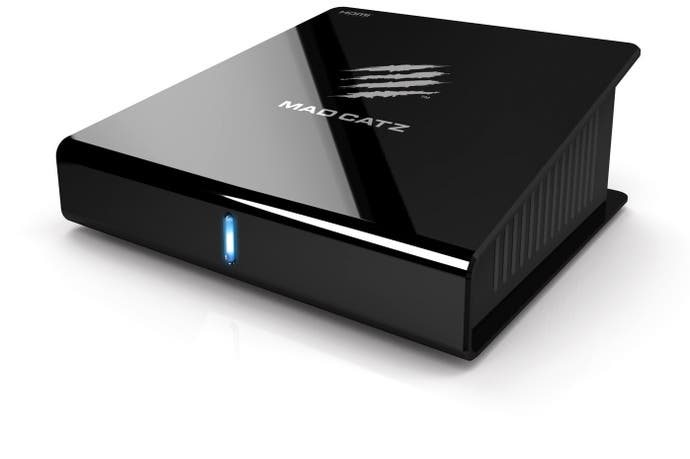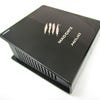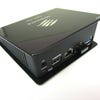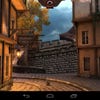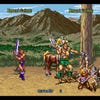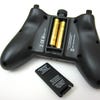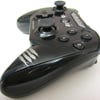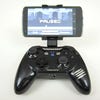Mad Catz Mojo review
Can the case be made for a £220 Android micro-console?
Despite the lukewarm commercial and critical response to Android micro-consoles such as the Ouya and GameStick, activity in this nascent sector of the market continues unabated. Huawei has recently announced its Tron system for the Far Eastern market, while leaked benchmark results suggest that Asus is readying a Tegra 4-based system called the Gamebox. Perhaps most exciting of all is Amazon's proposed gaming system, which has developer Double Helix - fresh off the back of retro reboots Killer Instinct and Strider - creating software for it.
In the here and now, we have the Mad Catz Mojo (or M.O.J.O. as the firm puts it, despite the acronym not actually standing for anything), one of the more high-profile Android micro-consoles seen so far. Unlike the Ouya and GameStick, this system hasn't been crowd-funded and doesn't skimp on technical specifications; it's crafted by a peripheral maker with years of experience and boasts the same Tegra 4 chipset that powers the Nvidia Shield. It's clearly being positioned as a premium product and that's reflected in the price, which is an eye-watering £219.99 - more than double the cost of the Ouya and well above what traditional games consoles like the PlayStation 3 and Xbox 360 currently retail for.
As a physical device the Mojo is certainly appealing, and is arguably the best-looking Android micro-console so far - although given the relatively plain nature of the competition, this could be seen as damning with faint praise. The base unit is fashioned from glossy plastic and has a wedge-like shape, not totally dissimilar to a doorstop; the blue power light sits on the front, while the back of the machine is littered with an array of ports and sockets. You'll find a MicroSD card slot (to augment the system's 16GB of internal storage), HDMI out, 100Mbit ethernet connection and two USB ports - one 2.0 and one 3.0. There's also a headphone socket and - of course - the power input. There's no power button to speak of, and the only way to switch off the console entirely is to yank out that power cord. However, when the system slips into its standby slumber, its power consumption drops to practically nothing.
The Mojo's joypad is an altogether more interesting prospect; the Ctrlr (again, the name is purely a stylistic choice) is a wireless pad that is used not only with this micro-console, but any other device that supports Bluetooth controllers - it even comes with a special clamp allowing you to fuse it with your Android phone, effectively creating a portable games system. When used with the Mojo, the pad actually connects using a Bluetooth Smart dongle, that slots into one of the USB ports on the back of the console. This wireless standard boasts lower latency and longer battery life - Mad Catz quotes 100 hours from two AAA batteries.
One of the more interesting aspects of the Ctrlr is the switch found on its bottom edge. This has three settings: Smart (Mad Catz's own open-source compatibility standard which is used within its range of peripherals), Mouse (where it imitates a mouse) and PC Mode. The reason for this is simple; without a touchscreen, interacting with the Mojo console is a convoluted affair, and newcomers to the Android scene could well find themselves spending the first few hours just trying to figure out how to navigate the user interface. This is partly down to the fact that the Smart and PC Mode settings on the controller appear to behave in totally unpredictable ways depending on what app or game you're running, and partly because Mad Catz has taken the puzzling decision to ship the Mojo with a untouched, "stock" version of Google's Jelly Bean (also known as Android 4.2.2) - an OS designed to be used with a touchscreen.
Unlike the Ouya and GameStick, there's no controller-friendly custom menu interface here; what you get is exactly what you'd see on an Android phone or tablet running a vanilla version of Google's OS. As if to hammer this point home, in some sections of the UI the Mojo is even referred to as a "phone" rather than a console. While its rivals may try to hide their use of Android beneath colourful, controller-friendly menus, Mad Catz has gone to the other extreme and done absolutely nothing to customise the UI.
"The Tegra 4 chipset features plenty of power, but similar to Nvidia's Shield, that doesn't stop 3D games from exhibiting some pretty choppy frame-rates at times."
This reasoning for this move is simple; unlike its micro-console competitors, Mojo doesn't inflict a simplified and neutered version of Android on its users - here, you have access to all of the options you're accustomed to on your handset or tablet - right down to signing in with the same Google profile. That means there's no need to enter any more credit card details to make purchases, and it also allows you to take advantage of the same cloud storage options that you enjoy on your mobile device - it's possible to access Google Music right out of the box, for example. This unified approach will appeal massively to dedicated Android users - and in principle, at least - also applies to app and game support.
Ouya and Game Stick don't allow access to the Google Play store, instead forcing their owners to browse a more limited selection of software on a separate marketplace - which means users may end up purchasing a game twice, should they already own it on another Android device. The downsides are obvious, but the upshot of such a stringently curated library is that compatibility is assured. Mojo may potentially have access to a broader range of content, but actually finding a game which functions properly with the console is easier said than done.
A cursory glance at the Google Play store via the Mojo reveals some shocking omissions; many of the best games are entirely absent, while those which do appear are often accompanied by the stark message that "your device is not compatible with this version" and therefore cannot be downloaded. The reason for this worrying predicament is something we've already mentioned: the complete absence of a touch interface. Google filters content on a hardware basis, and if an app developer specifies that a touchscreen is needed, the app in question is instantly rendered incompatible with the Mojo - even if gamepad controls are supported. The system isn't unique in its approach; Nvidia's Shield also offers full Google Play support, but that particular device also features a touchscreen, allowing it to neatly avoid the compatibility issues that plague Mad Catz's console.
Also, on the Shield, Nvidia is able to overcome discoverability concerns with the TegraZone app store - a separate selection of games that support the Shield's physical interface and is never more than a button tap away. This unique marketplace doesn't actually host the games - instead, it points the buyer in the direction of the relevant Google Play page at the point of purchase, which keeps things neat and tidy when it comes to paying for content. TegraZone ships on the Mojo as well, but it's a universally available Android app rather than a bespoke store, which is the case on the Shield. It still comes in handy though, as it allows you to filter games based on physical controller support - but almost all of the highlighted games display the aforementioned "device not compatible with this version" message once selected.
"While we prefer stock Android over customised variants, the lack of touchscreen actually presents the Mojo with some fundamental compatibility issues, resolved only by rooting the device."
It would seem that Mad Catz is aware of this potentially fatal problem, as the company has gone as far as publicising and practically encouraging Mojo owners to root their console to gain wider access to games on Google Play. However, this process - which is essentially hacking your system to gain administrator privileges - is something that a great many buyers won't feel comfortable doing, and one has to ask why Mad Catz didn't ship the console with root access enabled from the start. It's possible that a future OTA update will fix this oversight, but therein lies another issue - by rooting your Mojo in the meantime to turn it into something even vaguely useful, you will also disable the console's ability to receive these firmware updates. It's possible to restore your system to its factory state, but the point remains - this is something buyers simply shouldn't have to do. [Update 27/2/14 10:56 GMT: Mad Catz has been in touch since this review was published and has pointed out that an OTA update has been tested on a rooted Mojo and the process worked as expected, but should users encounter any issues they will have the option to install updates manually.] Sideloading of apps and games is also possible, but again, newcomers who have never used an Android device before will have no idea of how to go about this rather obtuse process. Simply put, out of the box the Mojo is something of a disaster.
Still, when you do eventually manage to procure a title that isn't fussy about the lack of a touchscreen display, things take a sharp upwards turn. Tegra 4 ensures decent performance, with recent titles like Asphalt 8: Airborne and Dead Trigger 2 zipping along at a fair rate - at least when compared to other Android devices, that is. Similar to the Nvidia Shield, there are still moments when the frame-rate suffers. The experience is rarely a silky-smooth one but it's rarely serious enough to sully your overall enjoyment, but those expecting a console-like level of quality are going to come away disappointed.
Thankfully, the Ctrlr pad is almost as good as anything Sony, Nintendo or Microsoft have come up with, which is to be expected from a seasoned peripheral maker like Mad Catz. The controller is comfortable to use, with only the clicky fascia buttons and the fiddly nature of the mode switch proving to be downsides. Because the switch sits flush in the casing, finding it in a hurry is often tricky - and you'll be flicking it a lot during play in order to navigate the UI and toggle gaming controls, so this can quickly become an irritation. A rechargeable internal battery would have been nice, as well.
"Benchmarks reveal a pretty powerful piece of mobile kit, but curiously some games don't run quite as smoothly as they do on Nvidia Shield, which is curious as they share the same chipset with minor speed differences."
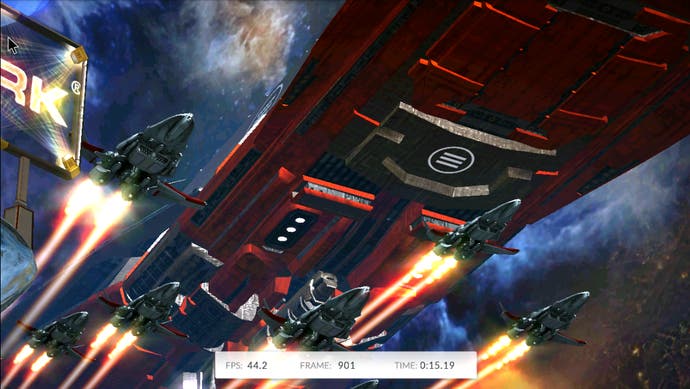
| Mad Catz Mojo | Nvidia Shield | Ouya | iPad Air | |
|---|---|---|---|---|
| GFXBench T-Rex Off-Screen | 18fps | 24fps | 4fps | 25fps |
| 3D Mark Ice Storm Extreme | Maxed Out | Maxed Out | 2251 | Maxed Out |
| 3D Mark Ice Storm Unlimited | 11237 | 11476 | 3617 | 14842 |
Given the generally awkward nature of interacting with the console via the pad, it's advisable to make use of Android's built-in support for Bluetooth peripherals. The process of entering text - which is positively painful when using the analogue stick of the Ctrlr - is much easier with a Bluetooth keyboard, and a wireless mouse is also highly recommended for making selections on-screen - the best thing is, both of these interface options can be used in tandem with the joypad. If for whatever reason the Ctrlr. pad doesn't float your boat, you can use other wireless pads or simply plug a wired Xbox 360 controller into one of the Mojo's USB ports. Android's open nature when it comes to physical interfaces means that Mad Catz's console takes advantage of several different solutions when it comes to input - it's just a shame that most of these will require additional investment on behalf of the consumer.
It's difficult to talk about Android consoles and not touch upon emulation - something that is extremely popular on Google's platform but continues to occupy rather shaky legal ground. We tested Mega Drive, SNES, Neo Geo and MAME emulation on the system, and came away thoroughly impressed; such a device effectively allows you to enjoy decades of gaming brilliance all in one place - assuming you have no qualms about breaking copyright law, of course.
Puzzlingly though, the Mojo's overall performance isn't always as spritely as the Nvidia Shield in this area. Certain arcade titles - such as Sega's Golden Axe: Revenge of Death Adder and the cult Raizing shooter Battle Garegga - run noticeably slower on Mad Catz's machine than they do on Nvidia's handheld. Why this should be the case is unknown; both systems are packing Tegra 4 chipsets, although the one in the Shield runs slightly faster - 1.9GHz compared to the 1.8GHz of the Mojo - and they both come equipped with 2GB of RAM. The difference in clock speed could be the root cause, but the variation in performance is so striking that it seems unlikely it's all that is to blame. Perhaps the active cooling on the Shield serves to limit throttling of processing power?
Mad Catz: Mojo: the Digital Foundry verdict
After the disappointment of the Ouya and GameStick, many believed that the Mojo would finally fulfill the latent promise of the Android micro-console concept by marrying top-range hardware with open and unified access to the Google Play store. In many ways, the company has achieved this - when it works, the Mojo delivers. The key issue is that getting to that point is like pulling teeth, and the process makes unreasonable demands of the end user. While we joke about modern consoles requiring massive software updates the very moment you switch them on from new, having to hook up the Mojo to your PC in order to hack its firmware is in a different league of inconvenience entirely, and many people will be reluctant to take the risk with a piece of gaming hardware that has just cost them over £200.
"In a world where the PS3 was on sale over Christmas for £99, the fundamental notion of a £220 Android micro-console doesn't compute."
Even if Mad Catz had hit the ball out of the park in every aspect of the console's core functionality and had removed the need to root the system to make it anywhere near usable, that lofty price point stills provides an almost insurmountable obstacle to many potential buyers. Mojo isn't really competing with its Android-based micro-console rivals - Nvidia Shield aside, of course - but rather traditional games consoles. Both the PS3 and Xbox 360 are significantly cheaper and have a vast library of games behind them, most of which can be obtained cheaply on the second-hand market for prices which won't be far off what Android developers are charging for the format's truly premium experiences (lest we forget Final Fantasy 6's £11 price tag).
Even the Nintendo Wii U - the commercial fortunes of which have been impacted by underwhelming third-party support - is infinitely better value than the Mojo at the same price, with the existence of The Legend of Zelda: Wind Waker HD and Super Mario 3D World alone. Taking all of this into account, it's all too tempting to compare the software available on Mojo with that on traditional consoles - and despite their low cost, there are simply no games on Android which can hope to challenge the likes of Dark Souls, The Last of Us or BioShock Infinite.
Every piece of hardware improves over time, of course, and Mad Catz could well take steps to alleviate some of the Mojo's irksome issues with timely firmware updates. There are also some fine ideas here - a joypad comes which can be used with your phone when you're out of the house being one of the most notable - and like so many Android devices, it can double as a pretty potent media centre if you're that way inclined. However, the single biggest negative is that all of this is available elsewhere and in a superior form; for a little more outlay, you can pick up the Nvidia Shield which not only comes with a "console" mode which allows it to emulate the performance of the Mojo (albeit without problems relating to apps, thanks to the inclusion of a touchscreen) but is also a portable system in its own right, and is able to stream PC games to boot. Nvidia's handheld unit remains the only viable example of an Android micro-console, and while Mad Catz still has time to fix the situation, the Mojo simply cannot be recommended in its current form - or at anything near its current price.
Thanks to Dabs.com for supplying the Mad Catz Mojo micro-console used in this review.
